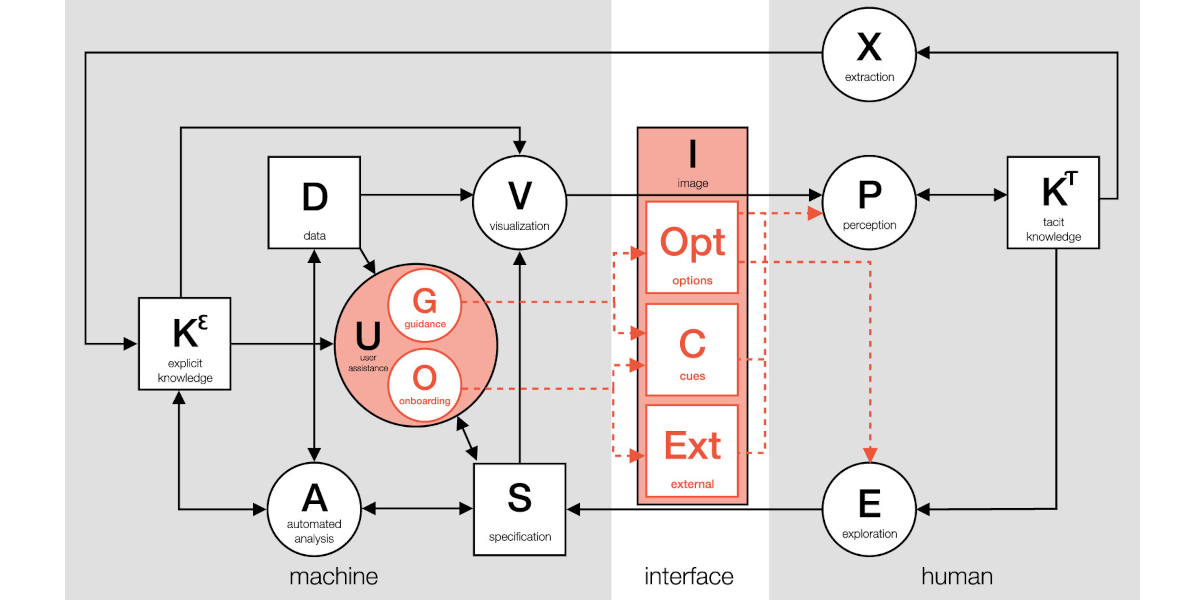
Abstract
A typical problem in Visual Analytics (VA) is that users are highly trained experts in their application domains, but have mostly no experience in using VA systems. Thus, users often have difficulties interpreting and working with visual representations. To overcome these problems, user assistance can be incorporated into VA systems to guide experts through the analysis while closing their knowledge gaps. Different types of user assistance can be applied to extend the power of VA, enhance the user’s experience, and broaden the audience for VA. Although different approaches to visualization onboarding and guidance in VA already exist, there is a lack of research on how to design and integrate them in effective and efficient ways. Therefore, we aim at putting together the pieces of the mosaic to form a coherent whole. Based on the Knowledge-Assisted Visual Analytics model, we contribute a conceptual model of user assistance for VA by integrating the process of visualization onboarding and guidance as the two main approaches in this direction. As a result, we clarify and discuss the commonalities and differences between visualization onboarding and guidance, and discuss how they benefit from the integration of knowledge extraction and exploration. Finally, we discuss our descriptive model by applying it to VA tools integrating visualization onboarding and guidance, and showing how they should be utilized in different phases of the analysis in order to be effective and accepted by the user.
Citation
Christina Stoiber,
Davide Ceneda,
Markus Wagner,
Victor Schetinger,
Theresia Gschwandtner,
Marc
Streit,
Silvia Miksch,
Wolfgang Aigner
Perspectives of Visualization Onboarding and Guidance in VA
Visual Informatics,
6(1):
68-83, doi:10.1016/j.visinf.2022.02.005, 2022.
BibTeX
@article{,
title = {Perspectives of Visualization Onboarding and Guidance in VA},
author = {Christina Stoiber and Davide Ceneda and Markus Wagner and Victor Schetinger and Theresia Gschwandtner and Marc Streit and Silvia Miksch and Wolfgang Aigner},
journal = {Visual Informatics},
publisher = {Elsevier},
doi = {10.1016/j.visinf.2022.02.005},
url = {https://doi.org/10.1016/j.visinf.2022.02.005},
volume = {6},
number = {1},
pages = {68-83},
year = {2022}
}
Acknowledgements
We would like to thank Frederico Limberger and Nelogica for their support in evaluating Profit, and all participants who attended our Application Spotlight Workshop at the IEEE Vis 2019 discussing and providing very helpful feedback to our approach. This work was supported by the Austrian Science Fund (FWF) as part of the projects VisOnFire and KnoVA (#P27975-NBL, #P31419-N31), the Vienna Science and Technology Fund (WWTF) via the grant ICT19-047 (GuidedVA), the Austrian Ministry for Transport, Innovation and Technology (BMVIT) under the ICT of the Future program via the SEVA project (#874018), as well as by the FFG, Contract No. 854184: ”Pro2Future” is funded within the Austrian COMET Program Competence Centers for Excellent Technologies under the auspices of the Austrian Federal Ministry for Transport, Innovation and Technology, the Austrian Federal Ministry for Digital and Economic Affairs, and of the Provinces of Upper Austria and Styria. COMET is managed by the Austrian Research Promotion Agency FFG.

